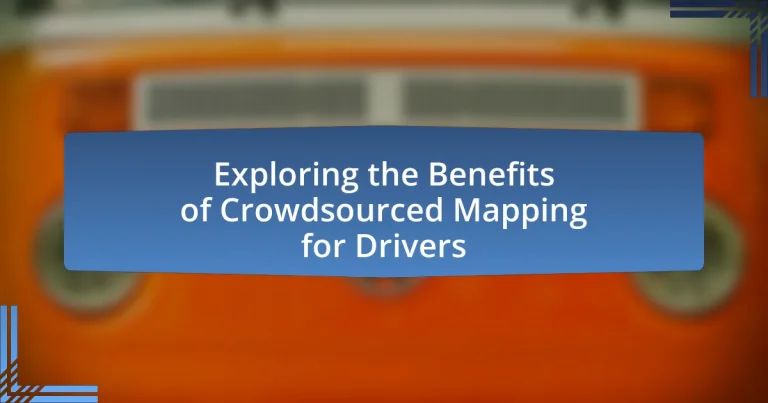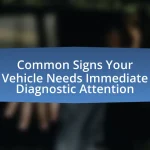Crowdsourced mapping for drivers is a collaborative approach that allows users to contribute geographic data, enhancing map accuracy and providing real-time traffic updates. This article explores how crowdsourced mapping functions, the technologies that enable it, and the various ways drivers can contribute to and benefit from this system. Key features include real-time traffic updates, user-generated points of interest, and route optimization, all of which improve navigation and driving safety. Additionally, the article addresses the challenges of data accuracy and user engagement, while highlighting best practices for maximizing the effectiveness of crowdsourced mapping platforms.
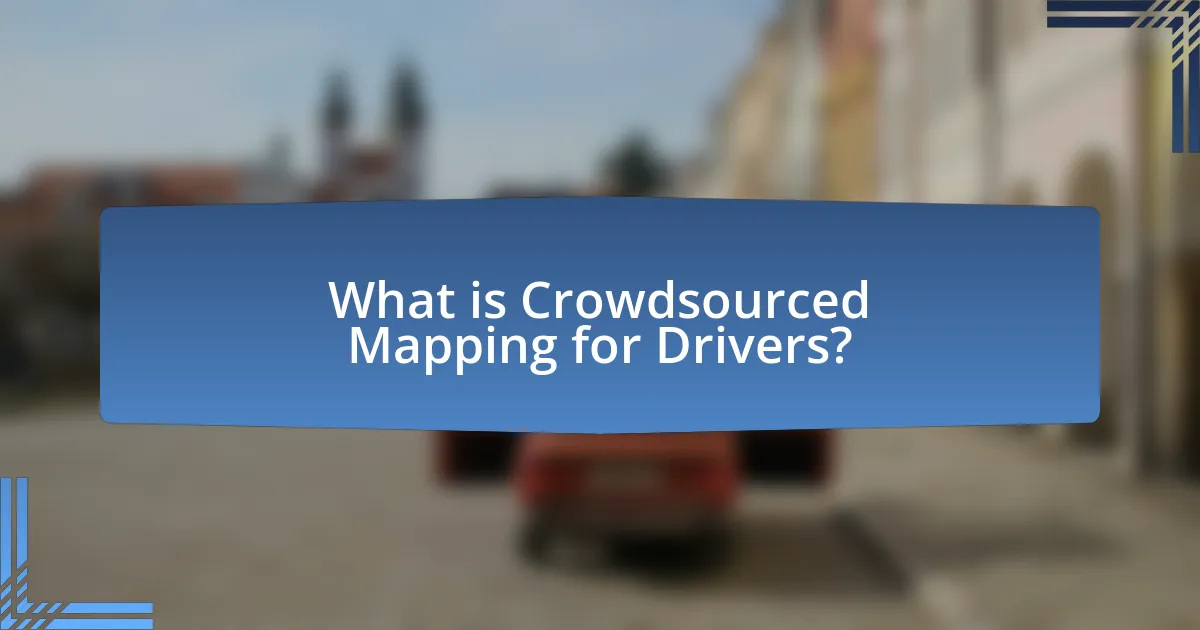
What is Crowdsourced Mapping for Drivers?
Crowdsourced mapping for drivers is a collaborative approach where users contribute geographic data and information to create and update maps. This method leverages the collective input of drivers to enhance map accuracy, provide real-time traffic updates, and identify road conditions or hazards. For instance, platforms like Waze utilize crowdsourced data to inform users about traffic jams, accidents, and road closures, demonstrating the effectiveness of this mapping technique in improving navigation and driving experiences.
How does crowdsourced mapping function in the context of driving?
Crowdsourced mapping functions in the context of driving by allowing users to contribute real-time data about road conditions, traffic patterns, and points of interest. This collaborative approach enhances navigation systems by providing up-to-date information that can improve route planning and driving efficiency. For instance, platforms like Waze utilize user-generated reports to alert drivers about accidents, road closures, and speed traps, which can lead to faster travel times and safer driving experiences. Studies have shown that crowdsourced data can significantly increase the accuracy of maps, with user contributions leading to more reliable navigation and better traffic management.
What technologies enable crowdsourced mapping for drivers?
Crowdsourced mapping for drivers is enabled by technologies such as GPS, mobile applications, and cloud computing. GPS technology allows users to determine their location accurately, while mobile applications facilitate real-time data collection and sharing among users. Cloud computing provides the infrastructure to store and process vast amounts of mapping data, enabling collaborative updates and access to information. These technologies collectively enhance the accuracy and timeliness of maps, as evidenced by platforms like Waze, which relies on user-generated data to provide traffic updates and route suggestions.
How do drivers contribute to crowdsourced mapping?
Drivers contribute to crowdsourced mapping by providing real-time data on road conditions, traffic patterns, and points of interest through mobile applications. This data is collected via GPS and user inputs, allowing mapping platforms to update and enhance their maps dynamically. For instance, platforms like Waze rely on drivers to report accidents, road closures, and speed traps, which improves navigation for all users. Research indicates that crowdsourced data can significantly increase the accuracy of maps, with studies showing that user-generated content can lead to a 30% improvement in map reliability compared to traditional mapping methods.
What are the key features of crowdsourced mapping for drivers?
Crowdsourced mapping for drivers includes real-time traffic updates, user-generated points of interest, and route optimization. Real-time traffic updates allow drivers to receive immediate information about congestion, accidents, and road conditions, enhancing navigation efficiency. User-generated points of interest provide insights into nearby amenities such as gas stations, restaurants, and rest areas, improving the overall driving experience. Route optimization features utilize data from multiple users to suggest the fastest or most efficient routes, which can significantly reduce travel time. These features collectively enhance navigation accuracy and driver convenience, supported by platforms like Waze, which reports that users can save up to 30% on travel time by utilizing crowdsourced data.
What types of data are collected through crowdsourced mapping?
Crowdsourced mapping collects various types of data, including geographic information, points of interest, road conditions, traffic patterns, and user-generated content such as reviews and photos. Geographic information encompasses coordinates, boundaries, and elevation data, while points of interest include locations like restaurants, gas stations, and landmarks. Road conditions involve real-time updates on closures, hazards, and construction, and traffic patterns provide insights into congestion and travel times. User-generated content enhances the mapping experience by adding personal insights and visual context. This data is often validated through user contributions and can improve navigation and route planning for drivers.
How is the accuracy of crowdsourced mapping data ensured?
The accuracy of crowdsourced mapping data is ensured through a combination of user verification, algorithmic checks, and community feedback mechanisms. User verification involves contributors providing evidence or references for their edits, which helps validate the information. Algorithmic checks utilize machine learning techniques to identify anomalies or inconsistencies in the data, flagging them for review. Community feedback mechanisms allow users to report inaccuracies, prompting corrections and updates. Studies have shown that platforms employing these methods, such as OpenStreetMap, maintain a high level of accuracy, with research indicating that crowdsourced data can be as reliable as traditional mapping sources when properly managed.
What advantages does crowdsourced mapping provide for drivers?
Crowdsourced mapping provides drivers with real-time updates on traffic conditions, road closures, and hazards. This dynamic information allows drivers to make informed decisions about their routes, potentially reducing travel time and improving safety. For instance, platforms like Waze utilize data from users to alert others about accidents or traffic jams, which can lead to more efficient navigation. Additionally, crowdsourced mapping can highlight alternative routes that may not be available through traditional mapping services, further enhancing route optimization for drivers.
How does crowdsourced mapping enhance navigation for drivers?
Crowdsourced mapping enhances navigation for drivers by providing real-time updates and accurate information about road conditions, traffic patterns, and points of interest. This collaborative approach allows users to contribute data, which leads to more precise and timely navigation guidance. For instance, platforms like Waze utilize user-generated reports to inform drivers about accidents, road closures, and speed traps, significantly improving route planning and travel efficiency. Studies indicate that crowdsourced data can reduce travel time by up to 20% in congested areas, demonstrating its effectiveness in enhancing the driving experience.
What role does real-time data play in improving driving experiences?
Real-time data significantly enhances driving experiences by providing up-to-the-minute information on traffic conditions, road hazards, and navigation updates. This immediate access to relevant data allows drivers to make informed decisions, such as choosing alternative routes to avoid congestion or identifying nearby services. For instance, studies show that navigation apps utilizing real-time data can reduce travel time by up to 30% during peak hours, demonstrating the tangible benefits of such information in optimizing driving efficiency and safety.
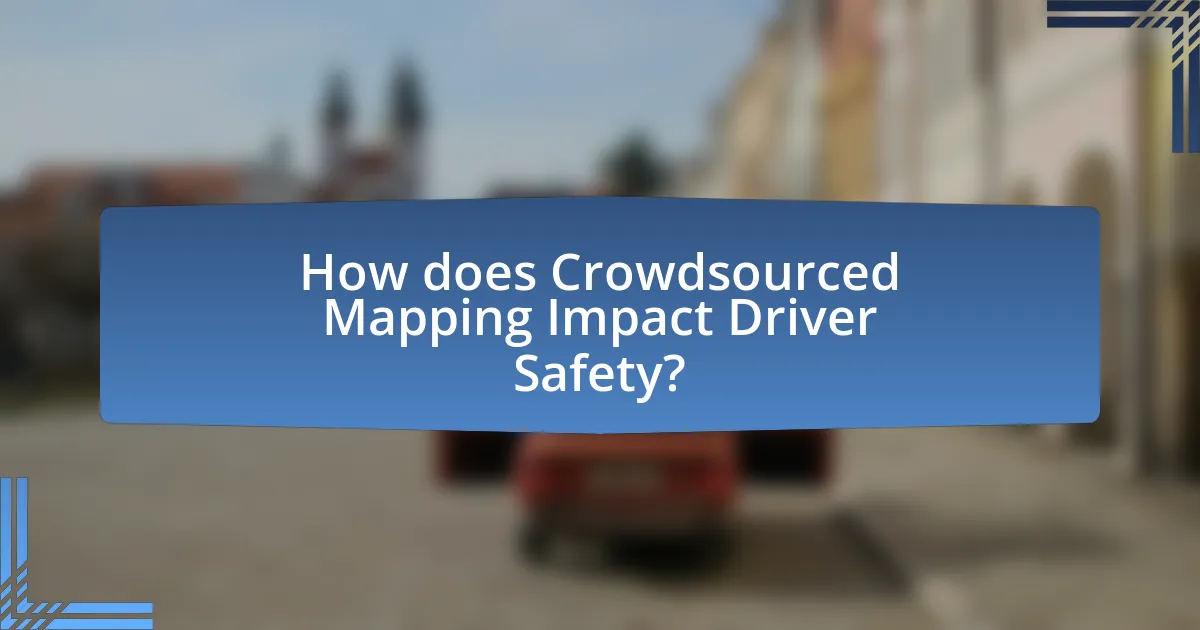
How does Crowdsourced Mapping Impact Driver Safety?
Crowdsourced mapping significantly enhances driver safety by providing real-time updates on road conditions, hazards, and traffic incidents. This dynamic information allows drivers to make informed decisions, reducing the likelihood of accidents. For instance, platforms like Waze utilize user-generated data to alert drivers about accidents, road closures, and speed traps, which can lead to safer driving routes. Research indicates that real-time traffic information can decrease accident rates by up to 20%, demonstrating the effectiveness of crowdsourced mapping in improving overall road safety.
What safety benefits does crowdsourced mapping offer to drivers?
Crowdsourced mapping offers significant safety benefits to drivers by providing real-time updates on road conditions, hazards, and traffic incidents. This dynamic information allows drivers to make informed decisions, avoiding dangerous situations such as accidents or road closures. For instance, platforms like Waze utilize user-generated data to alert drivers about accidents, police presence, and construction zones, enhancing situational awareness. Studies have shown that real-time traffic updates can reduce travel time by up to 20%, which indirectly contributes to safer driving by minimizing stress and distractions. Additionally, crowdsourced mapping fosters community engagement, encouraging drivers to report issues, thereby creating a more comprehensive and accurate representation of road safety conditions.
How can crowdsourced mapping help in identifying hazardous road conditions?
Crowdsourced mapping can help identify hazardous road conditions by aggregating real-time data from multiple users who report issues such as potholes, accidents, or poor weather conditions. This collective input allows for a comprehensive overview of road safety, enabling authorities and drivers to pinpoint high-risk areas quickly. For instance, platforms like Waze utilize user-generated reports to update traffic conditions and hazards, demonstrating that crowdsourced data can lead to timely alerts and improved navigation. Studies have shown that such systems can reduce accident rates by providing drivers with critical information about road conditions, thereby enhancing overall safety.
What impact does community reporting have on driver safety?
Community reporting significantly enhances driver safety by providing real-time information about road conditions, hazards, and traffic incidents. This collective input from local drivers allows for timely updates that can alert others to dangers such as accidents, road closures, or hazardous weather conditions. For instance, a study by the University of California, Berkeley, found that crowdsourced data can reduce accident rates by up to 20% in areas where such reporting is actively utilized. This evidence demonstrates that community reporting not only informs drivers but also contributes to safer driving environments through shared knowledge and awareness.
How does crowdsourced mapping contribute to traffic management?
Crowdsourced mapping significantly enhances traffic management by providing real-time data on road conditions, traffic congestion, and incidents. This data is collected from users who share their experiences and observations, allowing traffic management systems to analyze patterns and make informed decisions. For instance, platforms like Waze utilize crowdsourced information to update users about traffic jams, accidents, and road closures, which can lead to more efficient routing and reduced travel times. Studies have shown that such systems can decrease congestion by up to 30% in urban areas, demonstrating the effectiveness of crowdsourced mapping in optimizing traffic flow and improving overall transportation efficiency.
What insights can be gained from crowdsourced mapping data for traffic flow?
Crowdsourced mapping data provides insights into real-time traffic conditions, congestion patterns, and route optimization. By aggregating data from multiple users, it reveals peak traffic times, accident hotspots, and alternative routes that can alleviate delays. For instance, studies have shown that platforms utilizing crowdsourced data can improve traffic prediction accuracy by up to 30%, enabling drivers to make informed decisions about their travel routes. This data-driven approach enhances overall traffic management and contributes to reduced travel times and improved road safety.
How can cities utilize crowdsourced mapping to improve infrastructure?
Cities can utilize crowdsourced mapping to improve infrastructure by collecting real-time data from residents about road conditions, traffic patterns, and public amenities. This data allows city planners to identify areas needing repair or enhancement, prioritize projects based on community input, and allocate resources more effectively. For instance, a study by the Massachusetts Institute of Technology found that crowdsourced data can lead to a 20% increase in the efficiency of urban planning processes. By integrating this information into decision-making, cities can create more responsive and adaptive infrastructure systems that better serve their populations.
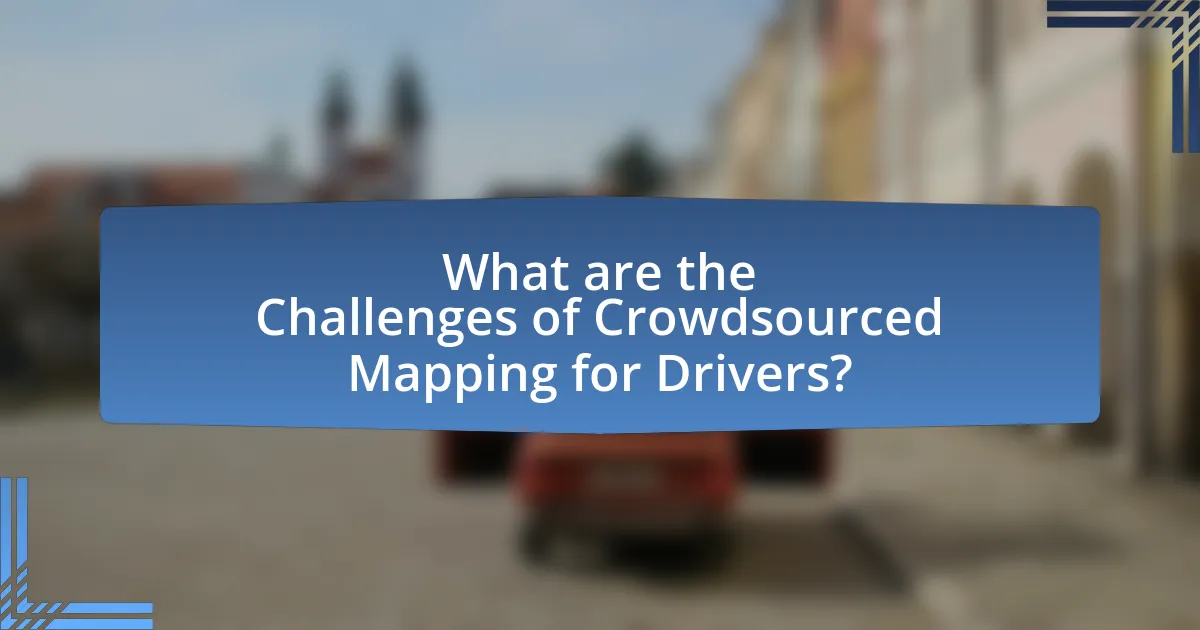
What are the Challenges of Crowdsourced Mapping for Drivers?
Crowdsourced mapping presents several challenges for drivers, primarily including data accuracy, inconsistent updates, and navigation errors. Data accuracy is a significant concern, as user-generated content may contain inaccuracies or outdated information, leading to incorrect routing. Inconsistent updates occur because contributions from users can vary in frequency and reliability, resulting in maps that do not reflect real-time conditions. Additionally, navigation errors can arise from misinterpretations of the data, causing drivers to follow incorrect paths or miss critical information such as road closures or traffic conditions. These challenges can hinder the effectiveness of crowdsourced mapping in providing reliable navigation assistance for drivers.
What limitations exist in crowdsourced mapping data?
Crowdsourced mapping data has several limitations, including data accuracy, coverage gaps, and potential bias. Data accuracy can be compromised due to the varying expertise of contributors, leading to incorrect or outdated information. Coverage gaps often occur in less populated or rural areas where fewer users contribute, resulting in incomplete maps. Additionally, bias may arise from the demographics of contributors, as certain groups may over-represent specific regions or types of data, skewing the overall representation. These limitations can affect the reliability and usability of crowdsourced mapping data for drivers.
How does data quality affect the reliability of crowdsourced mapping?
Data quality significantly impacts the reliability of crowdsourced mapping by determining the accuracy and completeness of the information provided. High-quality data ensures that the mapped features, such as roads and landmarks, are correctly represented, which is crucial for navigation and decision-making. For instance, a study by Haklay (2010) in “How good is volunteered geographical information? A comparative study of OpenStreetMap and Ordnance Survey datasets” found that the accuracy of OpenStreetMap data varies, with higher quality data leading to more reliable mapping outcomes. Conversely, low-quality data can result in errors, misrepresentations, and outdated information, undermining user trust and the overall effectiveness of crowdsourced mapping initiatives.
What challenges do users face when contributing to crowdsourced mapping?
Users face several challenges when contributing to crowdsourced mapping, including data accuracy, user engagement, and technical barriers. Data accuracy is a significant concern, as contributors may lack the expertise to verify the information they provide, leading to potential misinformation. User engagement can be hindered by a lack of motivation or recognition, which affects the quantity and quality of contributions. Additionally, technical barriers such as limited access to technology or inadequate user interfaces can discourage participation. These challenges collectively impact the effectiveness and reliability of crowdsourced mapping initiatives.
How can these challenges be addressed?
To address the challenges of crowdsourced mapping for drivers, implementing robust data validation mechanisms is essential. These mechanisms can include user feedback systems, where inaccuracies reported by users are reviewed and corrected by a dedicated team, ensuring the reliability of the mapping data. Additionally, leveraging machine learning algorithms can enhance the accuracy of the maps by analyzing patterns in user contributions and identifying potential errors. Research indicates that platforms employing such validation processes, like Waze, have significantly improved data quality, leading to better navigation experiences for users.
What strategies can improve the accuracy of crowdsourced mapping?
Implementing validation processes significantly enhances the accuracy of crowdsourced mapping. Strategies such as peer review, where multiple contributors verify each other’s data, can reduce errors and improve reliability. Additionally, integrating machine learning algorithms to analyze and cross-reference data against established geographic databases can identify inconsistencies and flag potential inaccuracies. Research indicates that platforms employing these strategies, like OpenStreetMap, have seen a marked increase in data quality, with studies showing that user-generated content can achieve accuracy levels comparable to traditional mapping methods when validated effectively.
How can user engagement be enhanced in crowdsourced mapping initiatives?
User engagement in crowdsourced mapping initiatives can be enhanced by implementing gamification strategies. Gamification, which incorporates game-like elements such as rewards, challenges, and leaderboards, has been shown to increase participation and motivation among users. For instance, a study by Hamari et al. (2014) found that gamification significantly boosts user engagement in various online platforms, including mapping applications. Additionally, providing clear feedback and recognition for contributions can further motivate users, as evidenced by the success of platforms like OpenStreetMap, where contributors receive acknowledgment for their mapping efforts.
What are the best practices for utilizing crowdsourced mapping as a driver?
The best practices for utilizing crowdsourced mapping as a driver include ensuring data accuracy, engaging with the community, and leveraging real-time updates. Data accuracy is critical; platforms like OpenStreetMap have demonstrated that user-generated content can be reliable when contributors are encouraged to verify and update information regularly. Engaging with the community fosters a sense of ownership and encourages more contributions, as seen in successful projects where local users actively participate in mapping their neighborhoods. Additionally, leveraging real-time updates allows drivers to receive the most current information on traffic conditions, road closures, and hazards, enhancing navigation efficiency. These practices collectively improve the utility and reliability of crowdsourced mapping for drivers.
How can drivers effectively contribute to crowdsourced mapping platforms?
Drivers can effectively contribute to crowdsourced mapping platforms by providing real-time data on road conditions, traffic patterns, and points of interest. By actively reporting incidents such as accidents, road closures, or construction, drivers enhance the accuracy and reliability of the maps. Studies show that user-generated data significantly improves navigation systems; for instance, Waze relies on driver inputs to update traffic conditions, which has been shown to reduce travel times by up to 30%. Additionally, drivers can validate existing map information by confirming or correcting details about locations, which further enriches the mapping database.
What tips can help drivers maximize the benefits of crowdsourced mapping?
Drivers can maximize the benefits of crowdsourced mapping by actively contributing data, utilizing real-time updates, and engaging with community feedback. Actively contributing data, such as reporting traffic conditions or road hazards, enhances the accuracy and reliability of the mapping service, as evidenced by studies showing that user-generated content significantly improves map quality. Utilizing real-time updates allows drivers to receive the latest information on traffic, accidents, and road closures, which can lead to more efficient route planning. Engaging with community feedback helps drivers stay informed about changes and improvements in mapping services, fostering a collaborative environment that benefits all users.
